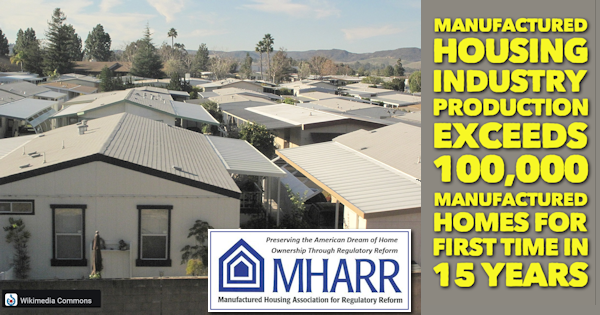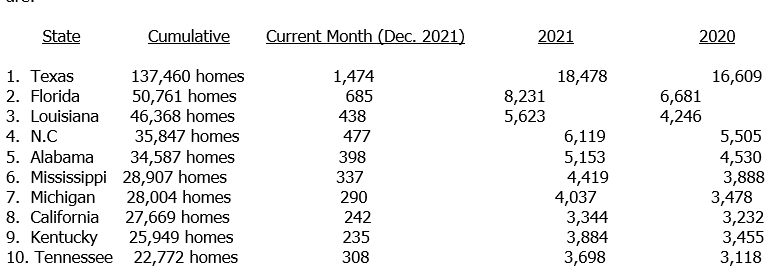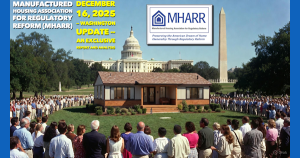Manufactured Housing Industry Production Exceeds 100,000 Manufactured Homes for First Time in 15 Years

Washington, D.C., February 3, 2022 – The Manufactured Housing Association for Regulatory Reform (MHARR) reports that manufactured housing industry production in 2021 has exceeded 100,000 homes annually for first time since 2006. According to official statistics compiled on behalf of the U.S. Department of Housing and Urban Development (HUD), HUD Code manufactured housing industry year-over-year production increased in December 2021, ensuring an annual production tally in excess of 100,000 homes. Specifically, just-released statistics indicate that HUD Code manufacturers produced 8,014 homes in December 2021, a 5% increase over the 7,633 new HUD Code homes produced during December 2020. As a result, 2021 ends with a cumulative production total of 105,772 homes, a 12% increase over the 94,390 homes produced over the same period in 2020.
A further analysis of the official industry statistics shows that the top ten shipment states from the beginning of the industry production rebound in August 2011 through December 2021 — with cumulative, monthly, current year (2021) and prior year (2020) shipments per category as indicated — are:

The December 2021 data results in no changes to the cumulative top-ten shipment list.
In Washington, D.C., MHARR President and CEO, Mark Weiss, stated: “While annual production in excess of 100,000 homes is significant and stands as a tribute to all those across the United States who work hard every day to produce and provide to Americans at all income levels, high-quality HUD Code homes that are safe and affordable, manufactured housing could and should be performing even better.” Weiss continued, “In a nation facing an affordable housing crisis where millions of additional homes are needed, but not currently available, inherently affordable manufactured housing should routinely have annual production levels in the hundreds-of-thousands of homes, but does not, due primarily to discriminatory zoning exclusions and restrictions, and the ongoing unavailability of secondary market and securitization support by Fannie Mae and Freddie Mac for the vast bulk of the manufactured housing consumer financing market. The entire industry, and most particularly its post-production sector – where these problems reside – must make their resolution and correction a top and continuing priority.”
Washington, D.C., February 3, 2022 – The Manufactured Housing Association for Regulatory Reform (MHARR) reports that manufactured housing industry production in 2021 has exceeded 100,000 homes annually for first time since 2006. According to official statistics compiled on behalf of the U.S. Department of Housing and Urban Development (HUD), HUD Code manufactured housing industry year-over-year production increased in December 2021, ensuring an annual production tally in excess of 100,000 homes. Specifically, just-released statistics indicate that HUD Code manufacturers produced 8,014 homes in December 2021, a 5% increase over the 7,633 new HUD Code homes produced during December 2020. As a result, 2021 ends with a cumulative production total of 105,772 homes, a 12% increase over the 94,390 homes produced over the same period in 2020.
A further analysis of the official industry statistics shows that the top ten shipment states from the beginning of the industry production rebound in August 2011 through December 2021 — with cumulative, monthly, current year (2021) and prior year (2020) shipments per category as indicated — are:

The December 2021 data results in no changes to the cumulative top-ten shipment list.
In Washington, D.C., MHARR President and CEO, Mark Weiss, stated: “While annual production in excess of 100,000 homes is significant and stands as a tribute to all those across the United States who work hard every day to produce and provide to Americans at all income levels, high-quality HUD Code homes that are safe and affordable, manufactured housing could and should be performing even better.” Weiss continued, “In a nation facing an affordable housing crisis where millions of additional homes are needed, but not currently available, inherently affordable manufactured housing should routinely have annual production levels in the hundreds-of-thousands of homes, but does not, due primarily to discriminatory zoning exclusions and restrictions, and the ongoing unavailability of secondary market and securitization support by Fannie Mae and Freddie Mac for the vast bulk of the manufactured housing consumer financing market. The entire industry, and most particularly its post-production sector – where these problems reside – must make their resolution and correction a top and continuing priority.”












